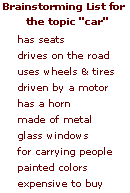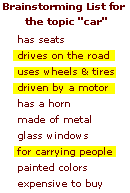![]()
Analyzing the Parts of a Topic
Introduction
Analyzing means looking closely at something and seeing what it's made up of. In a way, we're looking for the parts that define what it is you're analyzing. You might think of the thing as a type, class, or group of things that have enough in common that we can call them by one general name.
One simple example could be "car." We know a car usually has four wheels, an engine, and carries people on roads. If you change it to two wheels, we no longer have a car. If you say it carries people in the air, it's also not a car anymore. See how it works? Also, you can define smaller sub-groups. In our example using "cars" we could divide it into sub-groups like luxury, sports, or off-road. Each of these types is made up of certain parts, features, or characteristics that make the thing what it is. When you take away one of these certain things, we no longer have an example of that group.
We call these certain things "defining characteristics." "Defining" because the thing must have these characteristics (or attributes, or aspects, or features) in order to be part of the group. For example, if a vehicle flies in the air, not drives on roads, it couldn't be considered a car because it doesn't have the "car" critical attribute of being designed to drive on roads.
Analyzing your Topic
When you analyze a topic, you're basically looking very carefully at something or a group of things, trying to find out what makes them what they are and not something else. We can do it this way:

- Begin by listing or clustering everything that you can think of
that's important on your topic. For example, what are the smaller peices that make up the topic? What are things it has that are important? Your goal is to first get a really big picture and not miss anything. After you've done all your research and Internet investigation, take about 10 minutes to create this list.

- Using your list, now study it, looking for the main aspects.
For something to be in this topic, what are the things you're written down that you think are critical attributes or essential? For the "car" example, ask the question, "If it didn't have these things, would it still be a car?"
- Apply this question to each of the things on your list:
"If it didn't have this thing, would people still call it ________ ? Circle or highlight all the things you've listed that seem to be such defining characteristics.
- Choose what you think are the most important 2 - 4 characteristics
that make up the topic you're defining, then fill in this form to package your thinking.
http://www.web-and-flow.com/scaffolds/analysis.html